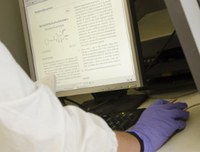
What happens when the pathogen responsible for the Covid-19 pandemic, the coronavirus Sars-CoV-2, makes contact with a human bronchial cell? A group of researchers from the Universities of Bologna and Catanzaro mapped the interactions between the virus proteins and those of humans, showing which proteins are being "activated" and "de-activated" by Sars-CoV-2.
"Gaining knowledge about the molecular effects of Sars-CoV-2 on human proteins is fundamental to devise effective drug therapies", says Federico M. Giorgi, principal investigator of this study and researcher at the University of Bologna. "Inhibiting the interactions that we mapped may represent an effective strategy for a therapy able to contain the disruptive force of Sars-CoV-2 and other coronaviruses on human cells".
This study was published on the Journal of Clinical Medicine and it allowed to identify human cells defense mechanisms, e.g. when the virus enters the body, as well as how the Sars-CoV-2 spreads in the human body, e.g. via proteins favouring its replication.
An integrated approach
Beta-coronaviruses, a sub-family of coronaviruses, mainly cause respiratory and intestinal diseases. To date, we are aware of 7 strains of beta-coronavirus which affect humans. Three of them are particularly dangerous: Sars-CoV, causing Sars, Mers-CoV, causing Mers, and the new Sars-CoV-2, causing Covid-19, the illness that already infected over a million people across the globe.
We know that Sars-CoV-2 has a lot in common with its beta-coronavirus "cousins", and with Sars-CoV in particular. Nevertheless, a detailed description of how this virus attacks human cells is still missing. To shed some light on this issue, researchers compared the interactome (the set of interactions between proteins) deriving from the encounter between Sars-CoV-2 and a human cell with the available information on the behaviour of Sars-CoV and Mers-CoV viruses.
"This integrated approach draws from our knowledge of other beta-coronaviruses and from what we have learnt about this new coronavirus so far. Crucially, it allowed to identify the main factors behind the action of Sars-Cov-2", explains Giorgi. "As a result, we were able to create a map showing which proteins are activated, thus increasing their production, and which are de-activated, consequently decreasing their quantity, when the virus attacks a cell of the human breathing system".
Attack and defence
This analysis allowed to identify some proteins which play a relevant role when the new coronavirus and a human cell meet. One of these proteins (MCL1) regulates the process of apoptosis (programmed cell death). Cells activate this process as an anti-viral defence mechanism, setting in motion a series of reactions, which eventually cause their own death in order to try to stop the attack of the virus. Other proteins are instead limited in their scope once they get in contact with the coronavirus. The deactivation of protein EEF1A1, for example, hinders the replicating ability of the virus.
The downside of this, however, is that Sars-CoV-2 also exploits some mechanisms in order to spread throughout the body. Indeed, researchers came to three main conclusions. Firstly, they found out that the virus is able to hinder the activity of mitochondria (the organelles in charge of cell respiration); secondly, they discovered that some specific viral proteins (NSP7 and NSP13) are able to de-activate some cell defence mechanisms; and thirdly, they observed the increase of some proteins that favour RNA metabolism and, as a consequence, the action and replication of the virus (whose genome is a single RNA strand).
Then there's ACE2, a protein famously combining with beta-coronavirus: it interacts with the "spikes" of the coronavirus, allowing it to enter the cells. The analysis shows that the cells fight the virus attack decreasing the presence of ACE2. Researchers also observed that a lower presence of this protein may damage lung tissues, thus favouring the spread of the virus anyway.
"This valuable information about the effects of the new coronavirus on the proteins of human cells may prove to be fundamental in redirecting the development of drug therapies, since common antiviral treatments seem to be unsuccessful", comments Federico M. Giorgi. "Recent advances in pharmaceutical science allow for the quick development of new molecules, which may prove to be very effective to counteract the action of the virus proteins and to improve the response of human cells".
Finally, researchers analysed the presence of ACE2 to shed some light on the animal origin of the Sars-CoV-2 coronavirus, which was initially ascribed to bats and then also to pangolins. This study brought to the fore a closer similarity between ACE2 proteins of human cells and those of pangolins. This result supports the hypothesis according to which this small mammal might have been the first host of Sars-CoV-2 or at least an intermediate one between bats and humans.
The authors of the study
The title of this study published on the Journal of Clinical Medicine is “Master Regulator Analysis of the SARS-CoV-2/Human Interactome”. The researchers who participated in the study are Federico M. Giorgi, Daniele Mercatelli and Carmine Ceraolo from the Department of Pharmacy and Biotechnology of the University of Bologna and Pietro H. Guzzi from the "Magna Græcia" University of Catanzaro.
